Arts and Health in Practice: Community Collaborations Through the University of Houston
Amanda Cachia
https://doi.org/10.52713/PFDE4649

Abstract
This chapters offers a general overview of the new Certificate in Arts and Health offered through the M.A. in Arts Leadership program in the Kathrine G. McGovern College of the Arts at the University of Houston. The chapter will focus on the nature of the collaborations that the certificate has established with healthcare organizations under the leadership of the program’s director. The Certificate in Arts and Health offers three classes: 1) Introduction to Arts and Health; 2) Healthcare Administration, Policy, and Research; and 3) Arts and Health in Practice, an elective. These classes are led by instructors who work in Houston Methodist Hospital’s Center for Performing Arts Medicine. Other primary collaborations are with Texas Children’s Hospital’s Periwinkle Arts in Medicine Program and the University of Texas MD Anderson Cancer Center’s Arts in Medicine Program. A discussion of the new book project, Hospital Aesthetics: Rescripting Medical Images of Disability, will follow, drawing connections to research, to classes in the certificate program, and within the Houston community. The last section of the chapter will introduce several graduates of the Certificate in Arts and Health program and will showcase the Arts and Health Fellowship. Graduates of the Certificate in Arts and Health program are prepared to embark on numerous paths in healthcare that emphasize the value of the arts for patient wellbeing.
Keywords: arts and health certificate, arts leadership and health humanities, Houston healthcare organizations
Introduction
This chapter offers a general overview of the new Certificate in Arts and Health offered through the MA in Arts Leadership program in the Kathrine G. McGovern College of the Arts at the University of Houston. The chapter will focus on the nature of the local collaborations that the certificate program has established with healthcare organizations under the leadership of Fleurette S. Fernando, director of the Arts Leadership program. The Certificate in Arts and Health offers three classes:
- Introduction to Arts and Health
- Healthcare Administration, Policy, and Research
- Arts and Health in Practice (elective)
These classes are led by instructors who work in Methodist Hospital’s Center for Performing Arts Medicine. Other primary collaborations are with Texas Children’s Hospital’s Periwinkle Arts in Medicine Program and the University of Texas MD Anderson Cancer Center’s Arts in Medicine Program. A discussion of the new book project, Hospital Aesthetics: Rescripting Medical Images of Disability, will follow, drawing connections to research, to classes in the certificate, and within the Houston community. The book will provide compelling new subject matter, which will attract new students who wish to lead transformative programs within our hospitals in the future, so that artists and patients alike will benefit from new approaches to medicine, disability, and the body. I am also hopeful that the book will serve as the basis for a future elective in the Certificate in Arts and Health, as a guide for a student intern, and as a resource for the Arts and Health fellow. The last section of the chapter will introduce several graduates of the Certificate in Arts and Health program and will showcase our Arts and Health Fellowship, which arose through the certificate program’s collaboration with Houston Methodist Hospital. Graduates of the Certificate in Arts and Health program are prepared to embark on exciting careers in healthcare that emphasize the value of the arts for patient wellbeing. In the conclusion, I discuss future directions for the certificate, which include the switch to online classes, the development of new electives, and innovative programming to benefit student networking and professional development opportunities.
The Graduate Certificate: Background and Collaborations Within Our Courses
According to the National Organization for Arts in Health (NOAH), there is a growing need for trained professionals who intimately understand how to integrate the arts into health and wellness programs. The University of Houston has responded to this call through the Graduate Certificate in Arts and Health. Todd Frazier, director of Houston Methodist’s Center for Performing Arts Medicine (CPAM), was a key figure in launching the certificate program, as he proposed the idea to Dean Andrew Davis at the College of the Arts. Frazier is a composer and an arts advocate, and he has long been motivated to broaden professional opportunities and the scope of education for artists and to expand the role and integrated value of the arts in communities. He has spent over 30 years supporting collaborations between education, medicine, and arts and culture in the US The Certificate in Arts and Health was designed to combine academic and professional training for students preparing to integrate the fine and performing arts into the areas of health, healthcare, and wellbeing. In 2019, thanks to Frazier’s prompt, the director of the Arts Leadership program, Professor Fleurette S. Fernando, developed the new graduate Certificate in Arts and Health under the auspices of the MA in Arts Leadership program in the Kathrine G. McGovern College of the Arts. A portion of the curriculum was designed to be delivered off-site in health and human services facilities in the city of Houston.
The arts are increasingly being used to reduce the experience of pain, help patients express needs and emotions, and create a welcoming and uplifting environment, especially in healthcare settings (Lambert et al. 2017). Such benefits are made possible by a diverse group of disciplines and professions engaging in ever-expanding ways with the arts, humanities, and design in the service of health and wellbeing. This is due in part to expansive new research showing that engaging in creative experiences is vital to human health, to bridging the life experiences that divide people and society, and to helping people understand the human condition (Lambert et al. 2017). Throughout the United States, the visual and performing arts are enhancing healthcare, promoting public health, and supporting community wellbeing. Instructors for the Certificate in Arts and Health see evidence of this every day. One of the instructors in the certificate program, Jennifer Townsend, says, “The arts, in their multifaceted forms, not only serve as aesthetic enhancements but also as essential elements in patient-centered care, contributing substantively to the holistic wellbeing of individuals.”
The city of Houston is the home of the Texas Medical Center (TMC), the largest medical center in the world. The TMC employs over 106,000 people and hosts over 10 million patient encounters annually. The TMC is also a leader in the developing field of arts in health, with award-winning programs already established in three hospital systems: Houston Methodist, MD Anderson, and Texas Children’s. A major goal of the certificate program is to supply these hospitals and other programs with students trained to be leaders at the intersection of arts and health. The certificate is designed to appeal to UH students enrolled in:
- Graduate degree programs in art, music, dance, and theatre
- The Arts Leadership Program in the McGovern College of the Arts
- The College of Liberal Arts and Social Sciences
- The College of Medicine, College of Nursing, and other programs in the health sciences
The certificate program has afforded the McGovern College of the Arts an opportunity to partner with Texas Medical Center leaders to design a program that contributes to our healthcare community by helping students develop hands-on skills for community and clinical work. The certificate curriculum also provides professional opportunities for students through credited internship placements, thereby supporting industry recruiting efforts and contributing to the growth of Houston’s broader creative economy.
The curriculum was designed after a survey of similar programs, including the exemplary Arts in Medicine Program at the University of Florida and the Cleveland Clinic’s Arts and Medicine Institute. The certificate requires nine credit hours. The two required courses are summarized below.
Introduction to Arts and Health (3 credits)
This course explores the theoretical foundations of the relationship of creativity to health and informs the field and practice of arts in medicine. This experiential course will be held in part in the Texas Medical Center and consist of lectures by established professionals in the field, tours of programs in session, and hands-on activities. Students will demonstrate a broad understanding of how the arts are used to improve health and wellbeing in healthcare environments, the patient experience, clinical services, caring for caregivers, health sciences education, and community health and wellbeing.
Healthcare Administration, Policy, and Research (3 credits)
This course is an overview of hospital administration, research, and evaluation in arts in medicine. Quantitative, qualitative, and mixed methods will be discussed, with an emphasis on arts-informed approaches for use in healthcare settings, be it in the hospital or in the community. Through video lectures, webinars, readings, writing assignments, and weekly discussions, students will learn the basics of developing a research proposal and evaluation plan.
Electives
The program also offers a number of electives, including an internship, which is a 150-hour placement in an arts integrated healthcare setting, and a 3-credit class called Arts and Health in Practice, which explores the practice of arts in medicine in the fields of health and human services. Some practices and topics covered in this course include art therapy, art in public health, art and design in the environment of care, art and compassion, art and human development, and the art of self-care. Other electives available come from the Arts Leadership graduate program, and these include Fundraising for the Arts, Public Relations and Marketing in the Arts, and Financial Management for the Arts.
The program’s three instructors work full-time at CPAM. They are Shay Thornton Kulha, manager of department operations (Image 1); Caroline Docwra, visual arts project specialist; and Jennifer Townsend, manager of creative arts therapies and an assistant professor of anesthesiology and critical care at the Houston Methodist Academic Institute (Image 2). For their classes, these instructors frequently partner with other healthcare organizations across the city, including the University of Texas MD Anderson Cancer Center (specifically Zachary Gresham, arts in medicine program manager), Texas Children’s Hospital (Carol Herron, Arts in Medicine Program coordinator), Menninger Clinic, Legacy Clinic, Hope Clinic, Culture of Health – Advancing Together (CHAT), Harris Health Ben Taub Hospital, and Memorial Hermann Hospital. Kulha also works with the Museum of Fine Arts, Houston, which is renowned for collaborating with medical schools to use art to help students build empathetic communication, teamwork, and cultural competency. Townsend has also worked with Covenant Children’s Hospital in Lubbock, Texas (which has partnered with Ballet Lubbock to employ a pediatric dancer in residence), with Storytelling: Stories and Songs (a UT Austin School of Nursing program that focuses on processing grief through stories and music), and with Houston Grand Opera, which presented an interactive workshop, “Cultivating Empathy Through Music and Storytelling” developed and facilitated by Alisa Magallón. The workshop is a music-based program that explores participants’ emotional responses to music and stories and offers tools to connect and empathize with others through exercises that strengthen self-awareness and deep listening skills.
These three instructors acknowledge that their partnerships with community and healthcare organizations have been invaluable for students pursuing the Certificate in Arts and Health, offering them deep insights into professional opportunities and networking. The goal, Kulha says, is not only to “define and provide an appropriate scope of work for the artists and arts leaders in healthcare environments, but also an educational program on how to build a more holistic healing environment through the arts in a COVID-19 world.” Indeed, because the Certificate in Arts and Health was launched during the COVID-19 pandemic, the program had to shift and orient itself to a virtual platform to ensure the safety of students and patients alike. While it was challenging to conduct classes without the benefit of being in-person—whether in the classroom or in various clinical settings—the virtual environment also offered many opportunities, not least the ability to invite guest speakers from across the country to share their rich experiences and knowledge of the field. Artistic programs that serve the health community can also be innovatively developed through the integration of technology, which is one of the trends predicted to grow in arts and healthcare settings in the future. Of particularly relevance here is the use of artificial intelligence, which can help detect disease, assist in drug development, and aid doctors’ interactions with patients, changing how patients get care.

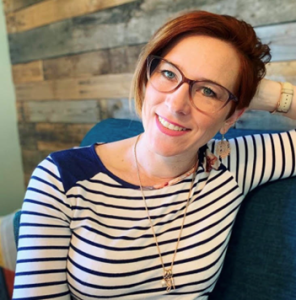
Images 1 and 2: Shay Kulha (left) and Jennifer Townsend (right), UH Certificate in Arts and Health instructors who are based at the Center for Performing Arts Medicine at Houston Methodist Hospital.
Book Project: Hospital Aesthetics: Rescripting Medical Images of Disability
In 2023, I began my new role as UH’s first tenure-track assistant professor of arts leadership and assistant director of the MA in Arts Leadership. In this position, I serve the Graduate Certificate in Arts and Health and the Graduate Certificate in Museum and Gallery Management. I am currently working on my second book, Hospital Aesthetics: Rescripting Medical Images of Disability, written with the support of a 2023 Andy Warhol Creative Writer’s Grant. The book draws on art history, visual culture, art therapy, disability studies, and innovative new studies in the medical industry that increasingly recognize the profound role that the arts have on hospitalized patients’ wellbeing, particularly during the post-COVID era. I argue that contemporary disabled artists are offering a new hospital aesthetics, where artists are taking health and care into their own hands and body-minds. Hospital aesthetics is defined as artwork that explores the ever-subjective experience of being sick and ill, which is set apart from, and outside of, a clinical and therapeutic setting, and which is in opposition to the medical model of disability. This hospital aesthetics is not interested in the wellbeing of hospital patients vis-à-vis art therapy; instead, it challenges the oppressive master narratives within the medical model that portray disability as something bad that must be fixed or corrected. In doing the work of hospital aesthetics, contemporary disabled artists are contributing to a type of disability activism that can simultaneously improve mainstream bioethics and ableist museum and gallery culture. This is because the work of contemporary disabled artists extends the imperative of decolonizing the gallery into the act of decolonizing the hospital; the artists I examine oppose the tendency for the medical-industrial complex to treat disabled bodies as specimens. Instead, their hospital aesthetics shows a different side to disabled bodies that attempts to undo the social and cultural impacts that hospitals have had on disabled patients.
The visual culture of medicine is one that generally undermines and controls disabled bodies at large, which ultimately has unfavorable outcomes on the physical and psychological care of disabled bodies. It is imperative and necessary, then, that disabled artists seek to establish a hospital aesthetics that rescripts these medical images of disability, both past and present, particularly in this age of the COVID-19 pandemic. While it is true that the term “hospital aesthetics” is reminiscent, etymologically, of “hospitable”—to be kind or cordial to strangers and guests, which is illustrated in contemporary disabled artist communities, where health and care are necessarily interdependent—the term also does much more. In doing the work of hospital aesthetics, both as process and product, contemporary disabled artists unleash a form of radical activism to empower themselves and the disabled and sick population to consider illness on their own terms, revealing the inadequacies of the medical-industrial complex.
The binary of hospitable versus inhospitable within the medical-industrial complex has additional resonance as it relates to the art gallery, too, which is a space that historically has privileged audiences based on class, race, education levels, and more. Hospital aesthetics can help to challenge and transform both the hospital and the art gallery into more welcoming sites, where the two venues can share critical dialogue and resources regarding the treatment of disabled bodies. To illustrate hospital aesthetics, my book examines the work of nine contemporary disabled artists and four care collectives in the US, Canada, and Europe that utilize a range of mediums: drawing, sculpture, installation, painting, performance, video, and socially engaged art practice.
My book also emphasizes that hospital aesthetics does not overlap with either art therapy or the interior design of hospital rooms. Instead, first and foremost, hospital aesthetics is a political movement. This is not to diminish the work of interior designers, art therapists, and other clinical workers, who are concerned primarily with individual patients’ wellbeing. In fact, there are several powerful art collectives who are working closely with hospitals to change the nature of the artwork displayed in hospital rooms, so the work is inherently more challenging, rather than soothing. For example, the UK-based art collective Hospital Rooms commissions world-famous artists to create site-specific installations for hospitals that specialize in treating patients with mental health challenges, anxiety, and depression. The Cleveland Clinic’s Arts and Medicine Institute also strives to curate museum-quality art experiences for hospital visitors, patients, and staff. The Cleveland Clinic also has its own full-time curator (and assistants). They work to curate selections for the Ohio campus and for the clinic’s other domestic and international sites. Many hospitals now also have arts in medicine programs with a mission to promote healing across the full plethora of art forms, including the visual arts, music, and performance. The overarching mission of CPAM, for example, is to translate the collaborative potential of arts and medicine to the healthcare environment.
To give the reader a tangible and compelling example of hospital aesthetics, I’d like to describe a series of works by Massachusetts-based disabled artist Dominic Quagliozzi, which he unofficially calls transformers (Image 3). Quagliozzi makes work that is informed by his lived experience with cystic fibrosis in addition to being a recipient of a double lung transplant in 2015. A transformer is not exactly the first image that comes to mind when considering a body that is affected by cystic fibrosis, but Quagliozzi compellingly makes this connection for us. Meant to be hung on the wall, a series of fabrics made from blue and green hospital gowns with a familiar medical motif are stretched over support frames in place of canvas. On the left and right sides of the frames are wood-block arms, also wrapped with the same hospital gown fabric, that fold at various points on hinges. They are pliable and flexible under the fingers of audiences, who are invited to play with the transformers to give them the possibility of unending new shapes and forms. Much like the concept of the original child’s transformers, these “bodies” can be transformed to imitate the gestures, folds, joints, and creases of human bodies. On a deeper symbolic level, transformers also showcase how a body with cystic fibrosis also shifts and transforms over time as organs lose strength and typical operation. While it is often the case that cystic fibrosis is a condition that is uncontrollable to the person inhabiting this body, through Quagliozzi’s transformers, he not only loosely documents the changes in his body in these abstract hybrid paintings/sculptures, but he also provides himself with talismans in which to channel change that is self-empowering, and indeed, more controllable. As someone who has spent a great deal of time in hospital settings, Quagliozzi has also embraced the materials of the hospital, as he believes they inhabit physical and symbolic memories of the patients that can generatively be utilized in his art practice for both their material and storytelling qualities. In using the quotidian materials of the hospital gown, which Quagliozzi admits are both stolen and taken with permission once they are deemed out of commission by a hospital, Quagliozzi aims to defamiliarize the familiar. Once decontextualized as works of art on a wall, they become humorous, heart-warming, and emptied of the vacant anonymity of rows of rooms with hospital bodies lined up down long hallways. Indeed, the hospital gown has been reconstituted into a hospital aesthetics.
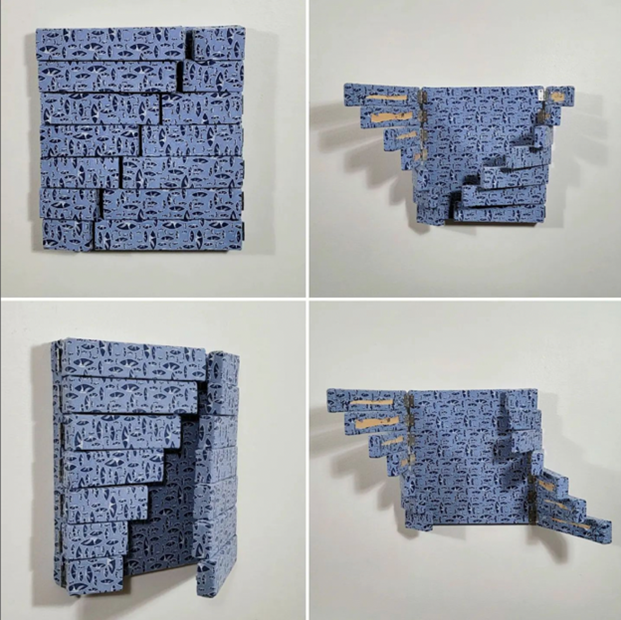
Image 3: Dominic Quagliozzi, untitled, hospital gown, hinges on wood, 10 x 10″.
My research will not only benefit the graduate students we serve and the many medical, art therapy, and community and cultural settings in the Greater Houston Area, but will also raise the profile of our programs. The Arts Leadership program is currently celebrating our tenth anniversary, and in the next ten years, we aim to increase our class offerings and student enrollments, particularly within the certificate programs that I manage. My book will provide compelling new subject matter, which will attract new students who wish to lead transformative programs within our hospitals in the future, so that artists and patients alike will benefit from new approaches to medicine, disability, and the body. Given that our program is housed in Houston, a city rich with both museums and medical facilities, I’m delighted that my work has found a suitable home in which to lead these critical new approaches and ideas. I am also hopeful that the book will serve as the basis for a future elective in the certificate program, as a guide for a student intern, and as a resource for each Arts and Health fellow, a position discussed later in this chapter.
Graduate Student Showcase
In this section, I briefly focus on the stories of two students who graduated from the MA in Arts Leadership program and successfully secured full-time employment in Houston healthcare institutions. The first is Caroline Docwra, who is one of the instructors in the Graduate Certificate in Arts and Health mentioned previously (Image 4). She is also a photographer, curator, and writer with a great passion for working with Houston’s communities and championing the healing potential of the arts. The various organizations with which Docwra has partnered include the Houston Arts Alliance, Houston Museum of Natural Science, Fort Bend Theatre, Houston Center for Photography, and the Children’s Museum of Houston. As the visual arts project specialist with the Center for Performing Arts Medicine at Houston Methodist, Docwra works to integrate the visual arts into the hospital’s environment of care. This work includes implementing art cart programs to bring art activities to patients’ bedsides, the Healing Arts photographic exhibition series for employees, and art installations throughout Houston Methodist’s eight campuses. During her time at Houston Methodist, Docwra has also built visual art programs from the ground up utilizing her past experiences, research, and learned best practices from the arts and health field. Visual arts programs at Houston Methodist incorporate evaluations for their effectiveness, follow policies and procedures that keep people safe, and allow for creative expression.
Docwra believes that art is a powerful instrument for healing, and that it can even be used as a prescription for certain ailments. She has positive memories of the power of the arts in hospitals from her own experiences navigating healthcare environments when family members were patients twenty years ago. She remembers feeling comforted and safe when she heard music being played on a piano and when she saw art on the walls. She realized that she was not alone in having this feeling and was excited to dedicate her career to helping patients through the presence of art in the hospital. Docwra says, “It’s incredible to see how the arts have physically impacted the patients…You see the connection when you are in an arts organization, but in a hospital setting, it takes on a more powerful meaning when it’s something that’s taking away a little bit of stress from a patient’s situation and replacing it with a positive moment.”
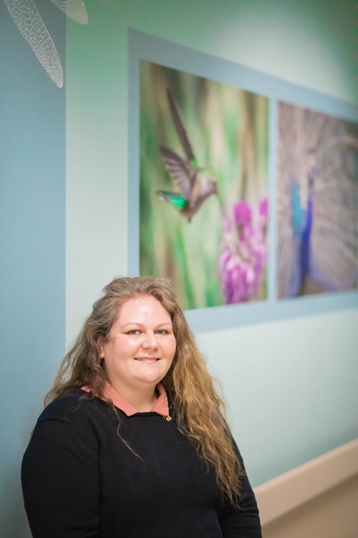 Image 4: Caroline Dowcra is the visual arts specialist at the Center for Performing Arts Medicine at Houston Methodist Hospital.
Image 4: Caroline Dowcra is the visual arts specialist at the Center for Performing Arts Medicine at Houston Methodist Hospital.
The second alumnus is Zachary Gresham. Previously, he worked at Art League Houston, Lawndale Art Center, the Museum of Fine Arts, Houston, and the Houston Mayor’s Office of Cultural Affairs. Additionally, he has played cello with the Symphony of Southeast Texas since 2009 and occasionally freelances as a cellist in the Houston area. Prior to teaching Technology in the Arts, a graduate seminar in the MA in Arts Leadership Program, Gresham taught Art in Elementary Schools, an art education course for upper-level education majors. Gresham is currently working as the Arts in Medicine Program manager at the University of Texas MD Anderson Cancer Center. In this role, he leads a dedicated team of workers to bring the power of the arts to pediatric inpatients (and their families) who are undergoing serious medical treatments. Gresham’s program incorporates all manner of artistic disciplines, including dance, music, theater, and the visual arts. Gresham says, “My current role at the hospital involves extensive in-house programming, where we rely heavily on our internal resources while also collaborating with various arts organizations from across the city” (Scott et al. 2023). Gresham and his team aim to ease patients’ anxiety and discomfort and to build a sense of community and belonging among all the patients and their families through the healing power of the arts. Some of Gresham’s activities have included community collaborations with local arts organizations, large-scale collaborative projects, and one-on-one art-making experiences.
One example of Gresham’s large-scale collaborative projects was the Postal Art Exchange. This endeavor began in spring 2018 as a way for patients and families to “travel” through their artwork (Image 5), despite the restrictions of the hospital walls. Inspired by the concept of mail art or correspondence art, this open-ended project appealed to all ages and art-making abilities. Prior to COVID (when the project was paused), over 100 postcards were completed by more than 150 artists (pediatric patients, their family members, and artists outside the hospital) from around the world. Artists from Canada, Chile, China, Colombia, Denmark, Italy, Pakistan, Peru, Portugal, Mexico, the US, and Venezuela are represented. Their postcards were exhibited on the sixth floor of the John P. McGovern Texas Medical Center Commons.
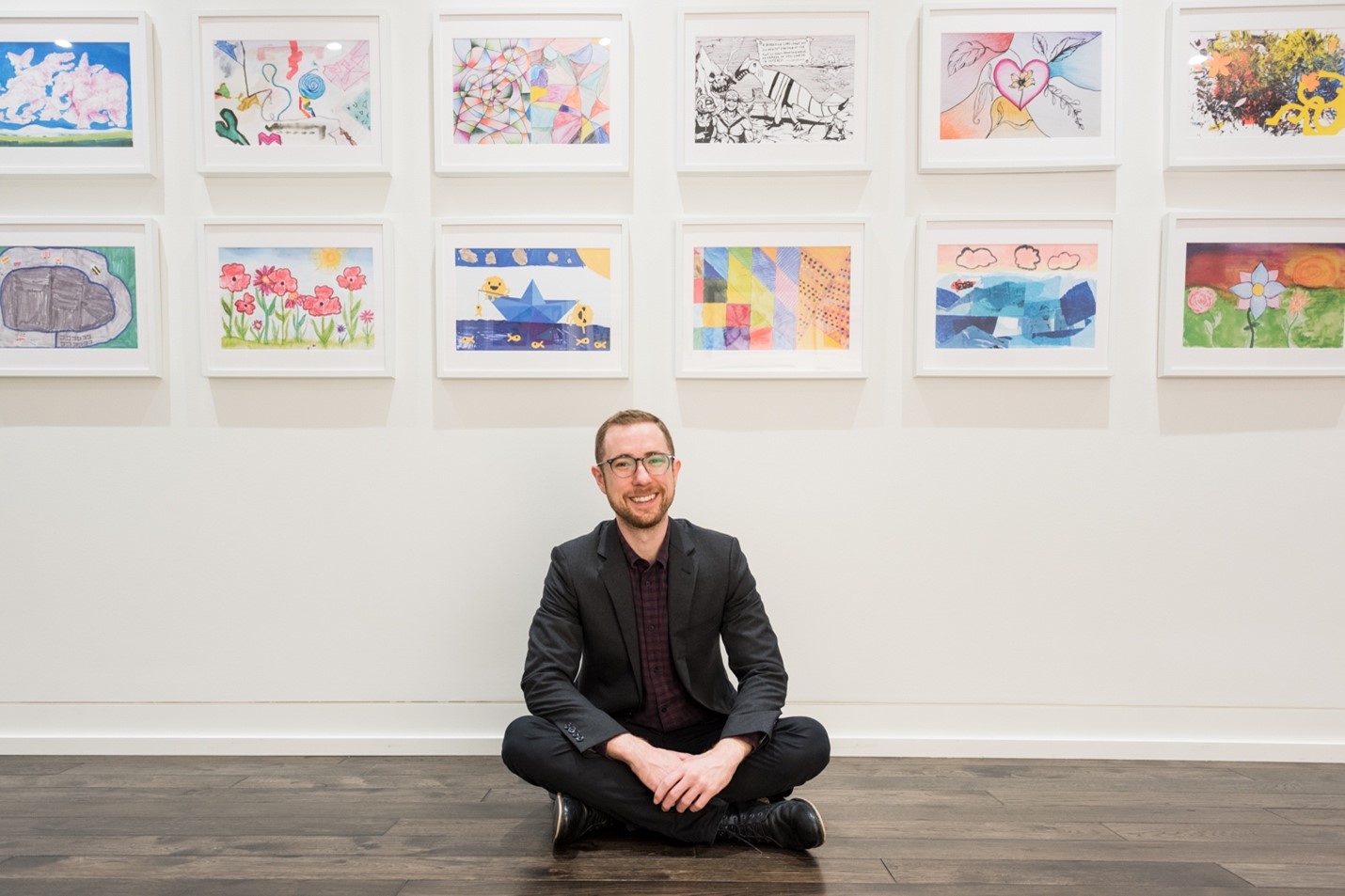
Image 5: Zachary Gresham at the University of Texas MD Children’s Cancer Hospital with the Postal Art Exchange project.
Arts in Health Fellowship, Kathrine G. McGovern College of the Arts
The Arts in Health Fellowship is a very exciting initiative that was developed in 2022 and is a joint program between the Kathrine G. McGovern College of the Arts and the Center for Performing Arts Medicine at Houston Methodist. The fellowship offers master’s students at the University of Houston an opportunity to curate artistic programming in response to a community health need. The fellow is responsible for working with communities to design, curate, and execute artistic programming throughout the course of a year in response to a community health need with a focus on mental wellbeing. This unique opportunity blends theoretical learning and practical application in the field of arts in health with a specific focus on arts in community health. The fellow has access to mentors, financial resources to support programming, and a unique vehicle designed by Houston artist GONZO247 as part of the Mobile Artists for Community Health Initiative (Image 6). The paid fellowship opportunity may also be counted for UH academic course credit. Fellows dedicate five to eight hours per week toward their project between mid-September and mid-May, and the job includes some remote work. This position was created to develop relationships with health organizations, provide new health resources to the Houston community, and act as a creative outlet for underrepresented and underserved communities. Over the course of the year, the fellow is encouraged to develop meaningful connections with artists and health professionals and to strengthen partnerships with Houston Methodist’s Center for Performing Arts Medicine and other peer organizations. The fellow’s experience will help them develop lifelong skills in organization management, event planning, research and education, and many other pivotal skills that will grow their career.
In its inaugural year, 2022, Donald Rabin was awarded the fellowship. During his time as fellow, he created the Fellows Guide, which includes resources for organizing arts-and-health-inspired performances in the Houston community, administrative contact information for performance venues in the area, and research on health equity and social determinants of health through an artistic lens. This led to the development of a strategic plan that included the purpose, mission, vision, and values of the fellowship, and the responsibilities for future fellows. At the conclusion of the 2022-23 academic year, Rabin coordinated with members of the College of the Arts Dean’s Council to host Creative Drama for Mental Wellness, a workshop that focused on integration of theater techniques into a mental health practice. The event provided participants with an opportunity to learn about positive psychology and social-emotional learning (SEL). The intention was to educate students on how they can incorporate these skills into their daily practice as future artists and educators. Artists Jonathan M. Ricardo, Samora Covington (PsyD), and Dr. Elizabeth Coen shared their expertise with several students over the course of two sessions. The addition of splatter paint was included to allow students an opportunity to decompress from the intensity of finals week. To conclude the event, Houston muralist GONZO247 unveiled the Arts and Health van (sponsored by Houston Methodist) that would serve as a representation of the partnership with UH and for the Arts in Health fellow to utilize at future performances. This was followed by a group meditation led by Dr. Alejandro Chaoul, director of the Jung Center’s Mind Body Spirit Institute.
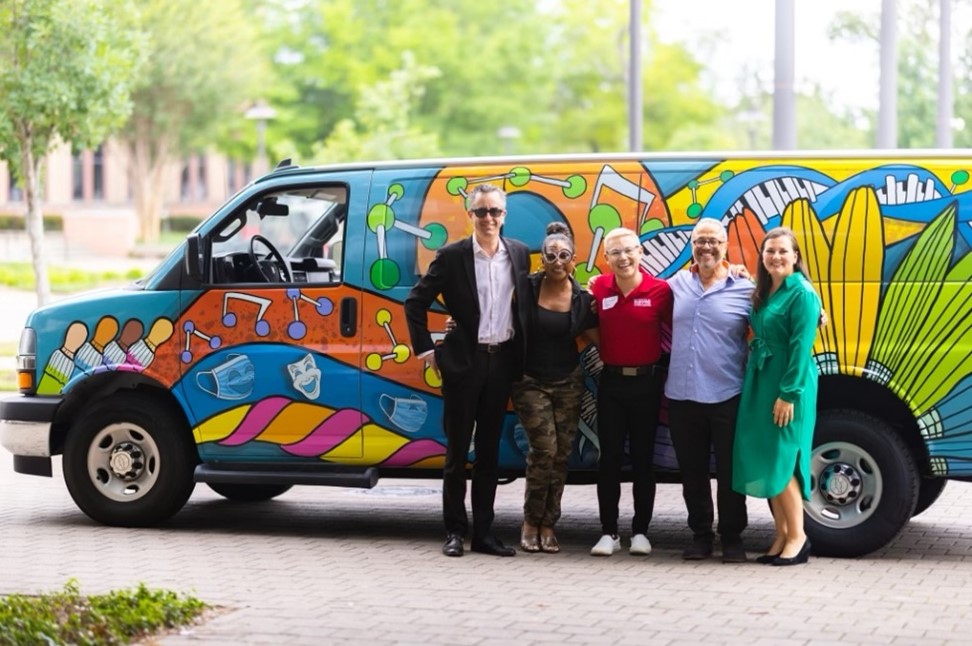
Image 6: Dean Andrew Davis, Professor Fleurette S. Fernando, Donald Rabin, Dr. Alejandro Chaoul, and Shay Kulha (left to right) standing in front of the mobile Arts and Health van designed by GONZO247, which facilitates pop-up performances at local venues as part of the Mobile Artists for Community Health Initiative.
In 2023, Claudia Ruiz holds the fellowship, and the community looks forward to seeing the outcome of her work in 2024 (Image 7). This fellowship will continue to provide the Houston community and University of Houston students an opportunity to learn about general wellbeing and health practices through the arts. The fellowship will make positive impacts in our community and will yield broad benefits.
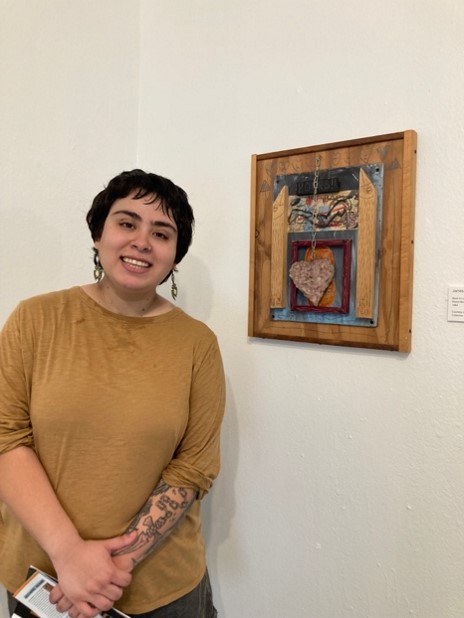
Image 7: Claudia Ruiz, the 2023-24 Arts in Health fellow, on a visit to Project Row Houses.
Conclusion
The Graduate Certificate in Arts and Health will continue to grow, as we have recently decided to turn the certificate into an exclusively online program. This will ensure that the classes are more accessible in a variety of ways, which will undoubtedly increase student enrollment. Namely, the courses will be less cost-prohibitive, alleviating the need for expensive on-campus parking. Students from across the US will be able to take the classes, which is aligned with the Arts Leadership program’s aim of appealing to working professionals who have busy lives. Lastly, but importantly, online classes are more accessible for people with disabilities who are unable to get to campus due to lack of transportation and other barriers that prohibit their mobility and ultimately their ability to participate in class alongside their non-disabled peers. We also firmly believe that online learning must be embraced as a more accessible modality, not simply as a byproduct of the COVID-19 pandemic but because the integration of technology and education can be a powerful engine of pedagogical evolution. Experiences in the virtual environment will also have applications within healthcare settings in which the arts play a significant role; we are excited to ensure that our students are equipped with all these skills. Other potential directions for the certificate program include the development of further electives, which could spring from student and faculty participation in the 2024 National Organization for Arts in Health conference to be hosted by the University of Houston. We also envision hosting a small, one-day symposium at UH for our certificate program students to network with others from Houston’s arts and health sector, increasing their professional opportunities. In turn, this would allow our students to remain on the Houston health community’s radar, where they can be consulted for their expertise and experience in a field that is rapidly demanding the attention of our communities in our bid for more meaningful and transformative access to healthcare.
References
Lambert, Patricia Dewey, Donna Betts, Judy Rollins, Jill Sonke, and Katie White Swanson. 2017. Arts, health, and well-being in America [White paper]. National Organization for Arts in Health.
National Organization for Arts in Health. (2017). Arts, health, and well-being in America. San Diego, CA: Patricia Dewey Lambert, Donna Betts, Judy Rollins, Jill Sonke, and Katie White Swanson. A white paper commissioned by the National Organization for Arts in Health.
Scott, Kayly M., Stephanie Berry and Greta J. Connolly. Arts and healing: UH arts leadership graduates making a difference. Kathrine G. McGovern College of the Arts Short Stories. https://kgmca.shorthandstories.com/uh-arts-leadership-graduates-making-a-difference. Accessed November 16, 2023.
Tubbs, Sara. “Art is Good Medicine: UH Graduate Certificate Program Integrates Fine and Performing Arts into Health Care Setting.” Kathrine G. McGovern College of the Arts Short Stories, https://stories.uh.edu/art-is-good-medicine/index.html Accessed November 16, 2023

